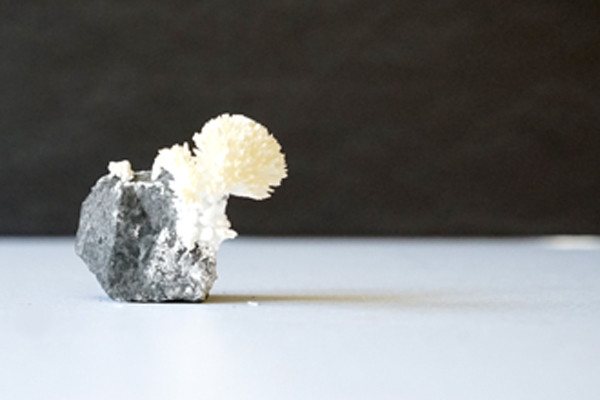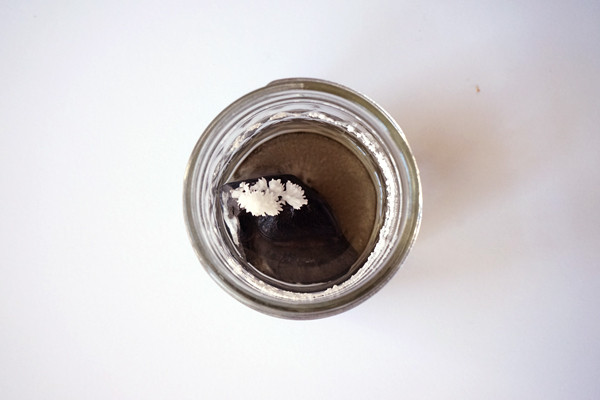Growing a rock might sound like science fiction, but with a little chemistry and the right materials, you can actually cultivate beautiful aragonite crystals on dolomite stones. At rockscapes.net, we’re passionate about bringing the beauty of geology into your home, and this guide will show you exactly how to do it. Discover the fascinating world of mineral formation and transform ordinary rocks into stunning crystal displays, exploring rock formation and unique landscaping rock.
1. What Exactly Does It Mean to “Grow” a Rock?
“Growing” a rock, in this context, doesn’t mean making a rock bigger, but rather encouraging the formation of crystals on its surface. This involves a chemical reaction where minerals dissolved in a solution precipitate out and form a crystalline structure on a host rock. It’s akin to creating a miniature, controlled version of the geological processes that form stunning mineral formations in nature.
1.1 What is Aragonite and Why is it Special?
Aragonite is a carbonate mineral, a polymorph of calcium carbonate (CaCO3), meaning it has the same chemical formula as calcite but a different crystal structure. Aragonite typically forms in marine and freshwater environments, as well as in caves as stalactites and stalagmites. Its needle-like orthorhombic crystals are what give it a unique aesthetic appeal.
According to research from Arizona State University’s School of Earth and Space Exploration, aragonite’s formation is influenced by factors like temperature, pressure, and the presence of other ions in the solution. These conditions dictate the rate and morphology of crystal growth, making each aragonite specimen a unique work of art.
1.2 What Role Does Dolomite Play in Crystal Growth?
Dolomite is a sedimentary rock composed primarily of the mineral dolomite (CaMg(CO3)2). In this experiment, dolomite acts as a substrate or base upon which aragonite crystals can grow. The magnesium content in dolomite can influence the nucleation and growth of aragonite crystals. Dolomite provides nucleation sites, meaning tiny imperfections or irregularities on the rock’s surface where crystal growth can initiate.
 Dolomite rock and aragonite crystal
Dolomite rock and aragonite crystal
1.3 Can You Use Other Types of Rocks Besides Dolomite?
While dolomite is commonly used due to its composition and availability, other rocks containing calcium or magnesium carbonates may also work, but results may vary. Limestone, for example, might support crystal growth, but the resulting crystals could differ in morphology or size. Experimentation can be part of the fun!
2. What Do You Need to Grow Your Own Crystals?
To embark on your crystal-growing adventure, you’ll need a few simple ingredients and tools. Gathering everything beforehand will ensure a smooth and enjoyable experience.
2.1 Essential Materials for Crystal Cultivation
- Dolomite Rocks: These serve as the foundation for your crystals. High-quality dolomite ensures better crystal formation.
- Distilled White Vinegar: The acidic nature of vinegar helps dissolve the dolomite and facilitates the formation of aragonite crystals.
- Glass or Ceramic Containers: To hold the rocks and vinegar. Mason jars are a popular and readily available option.
2.2 Where Can You Find Dolomite Rocks?
Educational Innovations offers dolomite rocks specifically for crystal growing projects. You can purchase 25 rock samples for just $8.95.
2.3 What Safety Precautions Should You Take?
While this experiment is generally safe, it’s always wise to take precautions:
- Adult Supervision: Especially for younger children.
- Eye Protection: Although vinegar is mild, it’s best to avoid getting it in your eyes.
- Ventilation: Work in a well-ventilated area.
- Hand Washing: Wash hands after handling vinegar and rocks.
3. Step-by-Step Guide: How to Grow Aragonite Crystals
Now that you’ve gathered your materials, let’s dive into the process of growing aragonite crystals. Follow these steps carefully for the best results.
3.1 Preparing Your Dolomite Rocks
- Selection: Choose your favorite dolomite rocks. Consider their shape and size.
- Cleaning (Optional): You can gently wash the rocks to remove loose sediment, but this isn’t strictly necessary.
3.2 Setting Up Your Crystal-Growing Station
- Container Placement: Place the dolomite rock in your chosen glass or ceramic container.
- Vinegar Pouring: Slowly pour distilled white vinegar into the container until the vinegar level is just below the top of the rock. The goal is to expose a small portion of the rock to air.
3.3 Monitoring Crystal Formation
- Observation: Observe the rocks daily. You should start seeing small crystals forming within a day or two.
- Evaporation: As the vinegar evaporates, crystals will continue to grow. The process typically takes about two weeks. You might notice crystals forming along the edges of the jar as well.
3.4 Drying and Handling Your Crystals
- Complete Evaporation: Wait until all the vinegar has evaporated and the rock is completely dry. This is crucial for the crystals to fully form and harden.
- Gentle Handling: Once dry, carefully remove the rock from the container. The crystals will be delicate, so handle them with care.
 Aragonite Crystals after 5 days
Aragonite Crystals after 5 days
4. Troubleshooting Common Issues
Even with careful preparation, you might encounter some challenges. Here are some common issues and how to address them.
4.1 What If No Crystals Form?
- Check Vinegar Quality: Ensure you’re using distilled white vinegar. Other types of vinegar might not work as well.
- Dolomite Quality: The dolomite rock might not be suitable. Try a different rock from your batch.
- Temperature: Ensure the environment is warm enough. Cooler temperatures can slow down crystal growth.
4.2 What If The Crystals Fall Apart?
- Premature Handling: The most common cause is moving or handling the jar before the crystals are completely dry.
- Humidity: High humidity can affect crystal formation. Try placing the jar in a drier location.
4.3 Can You Speed Up the Crystal Growth Process?
- Warm, Sunny Spot: Placing the jar in a warm, sunny spot will encourage evaporation and speed up crystal growth.
- Air Circulation: Gentle air circulation can also help with evaporation, but avoid direct drafts.
5. The Science Behind Crystal Growth
Understanding the science behind crystal growth adds another layer of appreciation to this project. Let’s explore the chemical reactions at play.
5.1 How Does Vinegar Dissolve Dolomite?
Vinegar, which is a dilute solution of acetic acid (CH3COOH), reacts with the calcium and magnesium carbonates in dolomite. The acetic acid dissolves the carbonates, releasing calcium, magnesium, and carbon dioxide.
5.2 What Causes Aragonite to Precipitate?
As the vinegar evaporates, the concentration of calcium and carbonate ions increases. When the solution becomes supersaturated, aragonite begins to precipitate out of the solution and form crystals on the dolomite surface.
5.3 Is This Process Similar to Natural Rock Formation?
Yes, in a way. Natural rock formations, like those found in caves or hot springs, also involve the precipitation of minerals from supersaturated solutions. However, natural processes occur over much longer timescales and under different geological conditions.
6. Creative Ways to Display Your Crystals
Once your aragonite crystals have grown, it’s time to showcase your geological artwork. Here are some creative ideas:
6.1 Incorporating Crystals into Your Home Décor
- Display Shelves: Arrange your crystal-covered rocks on shelves or display cases.
- Centerpieces: Use them as unique centerpieces for tables or mantels.
- Paperweights: Add a touch of natural beauty to your desk.
6.2 Using Crystals in Landscaping
- Rock Gardens: Incorporate your crystal rocks into rock gardens or other outdoor displays.
- Pathways: Use them to line pathways or create decorative borders.
- Water Features: Add them to water features for a sparkling effect.
6.3 Photography and Art Projects
- Still Life: Use your crystals as subjects for still life photography or paintings.
- Jewelry: Create unique jewelry pieces by incorporating small crystals into pendants or earrings.
7. Exploring Different Types of Rocks and Minerals for Landscaping
Beyond growing crystals, rocks and minerals play a crucial role in landscaping. Rockscapes.net offers a wide variety of options to enhance your outdoor spaces.
7.1 Popular Choices for Landscaping in the USA
- Granite: Known for its durability and variety of colors.
- Slate: Offers a natural, layered look and is often used for pathways and patios.
- River Rock: Smooth, rounded stones perfect for creating natural-looking water features or ground cover.
- Flagstone: Flat stones ideal for creating patios, walkways, and retaining walls.
7.2 How to Choose the Right Rocks for Your Project
- Consider Your Style: Choose rocks that complement your home’s architecture and your personal taste.
- Think About Functionality: Select rocks that are appropriate for the intended use, whether it’s for drainage, pathways, or decoration.
- Consider Local Availability: Using locally sourced rocks can reduce transportation costs and support local businesses.
7.3 Sourcing Quality Rocks from Rockscapes.net
Rockscapes.net is your one-stop shop for high-quality landscaping rocks and minerals. We offer a wide selection of materials, expert advice, and reliable delivery services.
8. Designing Stunning Rockscapes: Inspiration and Ideas
Creating a beautiful rockscape is an art form. Here are some ideas to spark your creativity:
8.1 Rock Gardens: Creating Natural Beauty
Rock gardens mimic natural alpine or desert environments, showcasing a variety of rocks and drought-tolerant plants.
8.2 Water Features: Adding Tranquility with Rocks
Combine rocks with water to create serene and visually appealing water features, such as waterfalls, ponds, or streams.
8.3 Pathways and Walkways: Guiding the Way with Stone
Use flagstone, gravel, or other types of rocks to create inviting pathways and walkways through your garden.
8.4 Retaining Walls: Functionality Meets Aesthetics
Build retaining walls using natural stone to create terraces, prevent erosion, and add visual interest to your landscape.
9. Maintaining Your Rockscapes: Ensuring Longevity and Beauty
Proper maintenance is key to keeping your rockscapes looking their best.
9.1 Cleaning and Preserving Natural Stone
- Regular Cleaning: Remove dirt, debris, and algae with a brush and water.
- Sealing: Apply a sealant to protect the stone from staining and weathering.
- Weed Control: Keep weeds at bay to prevent them from damaging your rockscapes.
9.2 Preventing Erosion and Damage
- Proper Drainage: Ensure adequate drainage to prevent water from pooling and eroding the soil around your rocks.
- Stabilization: Use geotextiles or other materials to stabilize slopes and prevent rocks from shifting.
9.3 Seasonal Care Tips
- Winter: Protect delicate stones from freezing and thawing by covering them with mulch or burlap.
- Summer: Provide shade for heat-sensitive plants growing in your rock garden.
10. The Future of Rock Landscaping: Trends and Innovations
Rock landscaping is constantly evolving. Here are some trends and innovations to watch out for:
10.1 Sustainable Landscaping Practices
Using locally sourced materials, incorporating drought-tolerant plants, and implementing water-wise irrigation techniques.
10.2 Incorporating Technology into Rockscapes
Integrating lighting, sensors, and smart irrigation systems to enhance the functionality and aesthetics of rockscapes.
10.3 The Use of Artificial Rocks and Minerals
Artificial rocks and minerals are becoming increasingly popular for their lightweight, durability, and customizable designs.
11. Understanding User Search Intent
Understanding what users are looking for when they search for terms related to “How To Grow A Rock” is crucial for creating relevant and helpful content. Here are five common search intents:
- Informational: Users seeking instructions on how to grow crystals on rocks at home.
- DIY/Tutorial: Users looking for step-by-step guides and materials lists for crystal-growing projects.
- Educational: Users wanting to learn about the science behind crystal formation and the types of minerals involved.
- Inspirational: Users searching for creative ways to display or use crystal-covered rocks in landscaping or home décor.
- Commercial: Users looking for suppliers of dolomite rocks, vinegar, or other materials needed for crystal growing.
12. FAQ: Your Questions About Growing Rocks Answered
12.1 Is It Really Possible to Grow a Rock?
Yes, but not in the way you might think. You’re not making the rock bigger, but rather encouraging the formation of crystals on its surface through a chemical reaction.
12.2 What Kind of Vinegar Should I Use?
Distilled white vinegar works best for growing aragonite crystals.
12.3 How Long Does It Take for Crystals to Grow?
Crystals typically start forming within a day or two, and the process takes about two weeks for complete evaporation and crystal formation.
12.4 Can I Use Other Types of Rocks Besides Dolomite?
While dolomite is recommended, other calcium or magnesium carbonate rocks may work, but results may vary.
12.5 Are the Crystals Permanent?
Aragonite crystals can be somewhat fragile, so handle them with care. Over time, aragonite may transform into calcite, another form of calcium carbonate.
12.6 Is This Experiment Safe for Children?
Yes, with adult supervision and proper safety precautions, such as eye protection and hand washing.
12.7 What If I Don’t See Any Crystal Growth?
Check the quality of your vinegar and dolomite, ensure the environment is warm enough, and be patient.
12.8 Can I Speed Up the Crystal Growth Process?
Placing the jar in a warm, sunny spot can help speed up evaporation and crystal growth.
12.9 How Should I Display My Aragonite Crystals?
You can incorporate them into home décor, landscaping, or photography projects.
12.10 Where Can I Find High-Quality Landscaping Rocks and Minerals?
Rockscapes.net offers a wide selection of rocks, minerals, and expert advice for all your landscaping needs.
Conclusion: Embrace the Beauty of Rocks and Crystals
Growing aragonite crystals on dolomite rocks is a fascinating and rewarding project that brings the beauty of geology into your home. Whether you’re a seasoned rock enthusiast or a curious beginner, this guide has provided you with the knowledge and inspiration to embark on your own crystal-growing adventure. And when you’re ready to take your landscaping to the next level, remember that rockscapes.net is your trusted source for high-quality rocks, minerals, and expert advice.
Ready to transform your outdoor spaces with the timeless beauty of stone? Visit rockscapes.net today to explore our wide selection of landscaping rocks, discover inspiring design ideas, and get expert advice from our team of professionals. Let us help you create the rockscape of your dreams! Contact us at Address: 1151 S Forest Ave, Tempe, AZ 85281, United States. Phone: +1 (480) 965-9011. Website: rockscapes.net.
